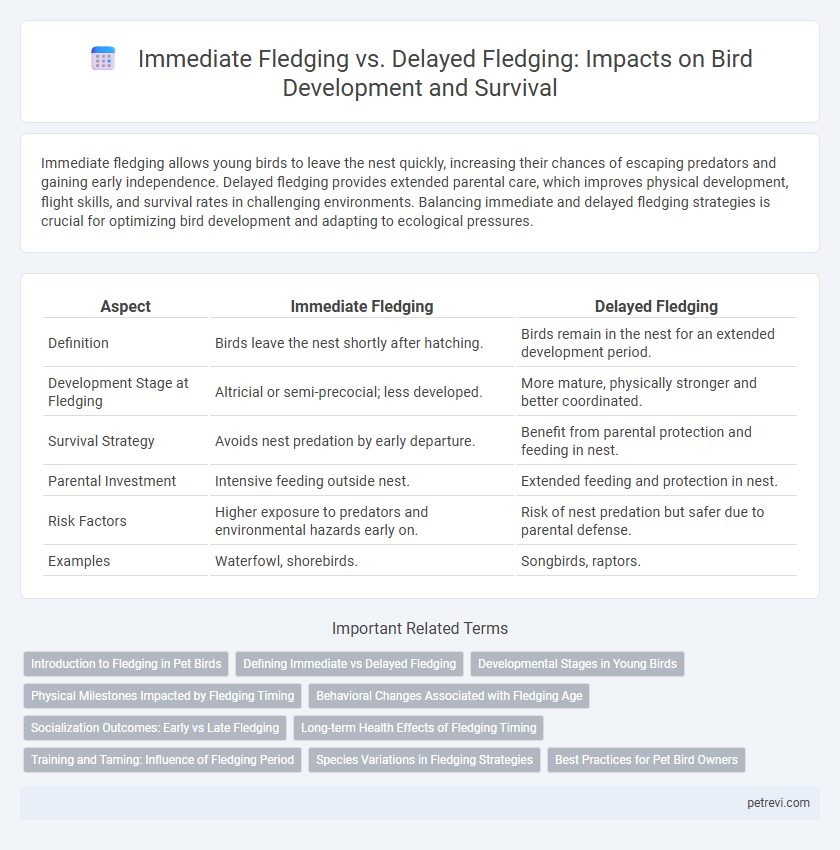Immediate fledging allows young birds to leave the nest quickly, increasing their chances of escaping predators and gaining early independence. Delayed fledging provides extended parental care, which improves physical development, flight skills, and survival rates in challenging environments. Balancing immediate and delayed fledging strategies is crucial for optimizing bird development and adapting to ecological pressures.
Table of Comparison
| Aspect | Immediate Fledging | Delayed Fledging |
|---|---|---|
| Definition | Birds leave the nest shortly after hatching. | Birds remain in the nest for an extended development period. |
| Development Stage at Fledging | Altricial or semi-precocial; less developed. | More mature, physically stronger and better coordinated. |
| Survival Strategy | Avoids nest predation by early departure. | Benefit from parental protection and feeding in nest. |
| Parental Investment | Intensive feeding outside nest. | Extended feeding and protection in nest. |
| Risk Factors | Higher exposure to predators and environmental hazards early on. | Risk of nest predation but safer due to parental defense. |
| Examples | Waterfowl, shorebirds. | Songbirds, raptors. |
Introduction to Fledging in Pet Birds
Fledging in pet birds marks the critical transition from nest dependence to independent flight, where immediate fledging species leave the nest shortly after hatching, while delayed fledging species remain nest-bound for extended development. Immediate fledging, common in precocial birds like ducks, allows rapid mobility but requires innate survival skills. Delayed fledging, typical in altricial birds such as parrots, involves prolonged parental care that supports brain growth and complex behaviors essential for pet bird training and bonding.
Defining Immediate vs Delayed Fledging
Immediate fledging refers to bird species in which chicks leave the nest shortly after hatching, often able to walk or feed themselves, exemplified by precocial birds like ducks and chickens. Delayed fledging occurs in altricial species where hatchlings remain in the nest, dependent on parental care for weeks until they develop sufficient plumage and flight muscles, as seen in songbirds and raptors. The distinction between immediate and delayed fledging is critical for understanding avian developmental strategies and survival adaptations.
Developmental Stages in Young Birds
Immediate fledging in birds refers to the rapid development where chicks gain independence shortly after hatching, often seen in precocial species with open eyes and down-covered bodies. Delayed fledging occurs in altricial species, where chicks remain in the nest longer, undergoing extended periods of growth and parental care before developing flight feathers and motor skills. These distinct developmental stages impact survival strategies, with immediate fledging favoring early mobility and delayed fledging allowing for more complex neural and muscular maturation.
Physical Milestones Impacted by Fledging Timing
Immediate fledging leads to earlier development of flight muscles and feather strength, enabling young birds to leave the nest quickly and avoid predation risks. Delayed fledging allows for extended growth of skeletal structures and wing loading adjustments, resulting in stronger, more coordinated flight capabilities. The timing of fledging directly influences physical milestones such as wing chord length, muscle mass, and neuromuscular control essential for survival and foraging efficiency.
Behavioral Changes Associated with Fledging Age
Immediate fledging in birds often results in earlier independence but may limit the development of crucial survival behaviors such as foraging and predator avoidance. Delayed fledging allows extended parental care and learning opportunities, enhancing skill acquisition and increasing post-fledging survival rates. Behavioral changes linked to fledging age include variations in flight proficiency, social interactions, and risk assessment, directly impacting juvenile adaptation to the environment.
Socialization Outcomes: Early vs Late Fledging
Immediate fledging in bird development often leads to accelerated socialization, enabling young birds to quickly learn essential survival skills through interaction with peers and adults in their environment. Delayed fledging provides prolonged parental care and social learning opportunities, which can enhance complex behaviors and stronger social bonds vital for species with intricate social structures. Studies show that the timing of fledging directly impacts social competence, influencing long-term success in territory establishment and reproductive behavior.
Long-term Health Effects of Fledging Timing
Immediate fledging often results in early independence but may increase vulnerability to predators and reduce development of critical survival skills, impacting long-term health and fitness. Delayed fledging allows extended parental care and skill acquisition, promoting better immune function, foraging efficiency, and overall resilience. Studies show that birds with delayed fledging tend to have higher survival rates and improved reproductive success later in life.
Training and Taming: Influence of Fledging Period
Immediate fledging in birds results in earlier exposure to environmental challenges, accelerating survival skills but often requiring intensive parental guidance for effective training and taming. Delayed fledging allows extended nest time, fostering stronger imprinting, more comprehensive feather development, and increased habituation to human interaction, improving tamability. The fledging period directly influences behavioral conditioning, with immediate fliers developing quicker independence while delayed fliers benefit from prolonged social learning and controlled training environments.
Species Variations in Fledging Strategies
Bird species exhibit significant variations in fledging strategies, with some favoring immediate fledging to reduce predation risk by quickly leaving the nest, while others adopt delayed fledging to enhance flight skills and foraging efficiency. Altricial species like songbirds typically practice delayed fledging, allowing extensive parental care and development before leaving the nest, whereas precocial species such as ducks often employ immediate fledging to exploit mobility advantages early. These differing approaches reflect adaptations to ecological niches, predator pressures, and life history traits, influencing survival rates and reproductive success across avian taxa.
Best Practices for Pet Bird Owners
Immediate fledging in pet birds involves rapid development, encouraging early independence and flight, which supports natural behaviors and physical health. Delayed fledging allows extended parental care, promoting stronger immune systems and social bonding, crucial for emotional stability in pet birds. Best practices for pet bird owners include providing a safe environment that balances flight practice with nutritional support, ensuring optimal development regardless of fledging timing.
Immediate fledging vs Delayed fledging for Bird development Infographic

 petrevi.com
petrevi.com